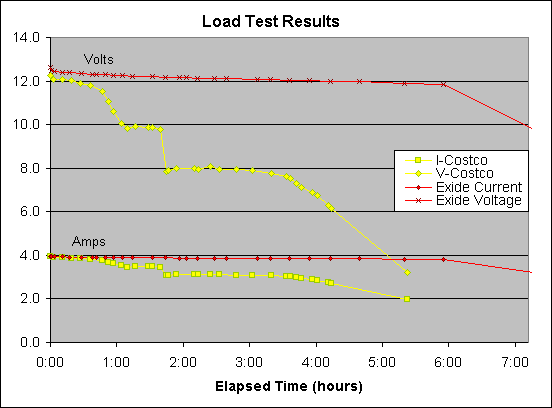
Barry's Coilguns
Mark 3
- Introduction
- Transformer
- Firing Tube
- Terminal Strips
- Photos
- Expenses
- Voltage Sweep
- Battery Test
Testing a Car Battery Under Load
The most common problem building a coilgun is finding a high-power electrolytic capacitor. Pulse-rated caps are expensive and hard to find. But ordinary car batteries are very common and store a huge amount of energy. And it just so happens that I have two used batteries available. First I must find out which one works the best.
How do you test a battery? You need a load tester. This web page describes a simple home-made load tester for testing relative battery performance.
The Load Tester
My "load tester" is simply an automotive headlamp bulb, in series with a low-value current-sensing resistor. This allows me to measure both current and voltage over time.
The headlamp bulb is a replacement bulb for my Toyota Corolla, mounted in a standard high-temperature headlight socket.
 The
current-sensing resistor R was built for at 0.02 ohm and 11 watts, constructed from eleven resistors
in parallel, each of 0.22 ohms resistance. To choose the current-sensing resistor value:
The
current-sensing resistor R was built for at 0.02 ohm and 11 watts, constructed from eleven resistors
in parallel, each of 0.22 ohms resistance. To choose the current-sensing resistor value:
- The added resistance should not affect headlight current
- The voltage drop should always be less than 5% of the total 12v:
VR = (0.05) * (12v) = 0.6v - The battery current is expected to be less than 30 amps
- Using Ohm's Law to find the maximum current-sensing resistance:
R = VR / I = (12v) / (30A) = 0.02 ohms  Check the power-handling requirement:
Check the power-handling requirement:
P = VI = (0.6v) * (30A) = 18 watts max
There is no on-off switch. Instead, I used quick-connect battery terminals. All connections are soldered for the lowest resistance.
The Batteries
Results
The Exide battery was surprisingly well behaved. In fact, it was annoying to have a brilliant headlight stabbing my eyes for over six hours. Then I went to bed for the night, and of course six hours later the battery measured less than one volt. It would have been interesting to see the discharge trajectory, but it's not quite interesting enough to run the test again.
Complete measurements can be found in this Excel spreadsheet (45k):

The 8-year old Costco battery has the strangest stair-step curve:
- It held steady at 12v for an hour, and then lost two volts
- It held 10v for an hour, then lost two volts again
- It held 8v for two hours and then steadily declined
- After the first two hours the bulb was vastly dimmer
- The "stair case" shape shows that lead-acid batteries are built from six 2-volt cells. As each cell failed, the voltage dropped by this amount.
- As a brand Costco batteries are a great buy -- keep in mind this particular battery was so old that it was already a couple years past its warranty period
If I run this test again, I need a higher-current load. It took over six hours to get a significant decline from a relatively new battery. The 4-amp load in this test should be increased to 10- or 20-amps for quicker results.
The current-sensing resistor is very useful. The load itself changed dramatically over time -- as with all incandescent loads, the resistance goes up as the bulb gets hotter. It was 3.1 ohms @ 12v, and 2.3 ohms @ 6v, and 1.6 ohms @ 3v, and finally 0.26 ohms at 0.1v.
This light is so bright and long-lasting, it would make a great emergency light during power outages. It needs a reflector or shroud so it doesn't dazzle your eyes, but the total light output over time is amazing.
| < Previous | Page 8 of 8 | Next > |
©1998-2024 Barry Hansen
